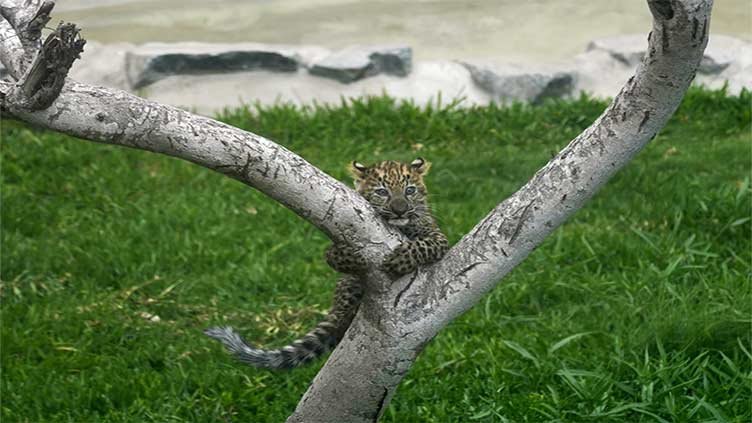By Sabra
In the heart of Lima, a remarkable spectacle unveiled itself as the sun began its gentle descent on a Wednesday evening. The debut of two precocious leopard cubs, snugly confined within their cages, injected a dash of vivacity into a tranquil zoo. These youthful cubs, a sprightly male and a feisty female, ventured to explore the vertical wonders of their world, defying gravity’s embrace by scaling the lofty trees within their confines. With curious eyes as vast as the Andean sky and teeth as sharp as Machu Picchu’s peaks, they embarked on a captivating spectacle before an enthralled audience.
These furry siblings, just beyond their third month of existence on this terrestrial stage, reveled in a circular dance as they exhibited their petite yet potent fangs. It was a mesmerizing display, akin to watching the celestial bodies pirouette in the night sky. Their custodian, a keeper of the wild, gingerly grasped their necks, extracting them from their subterranean abodes. The cubs, Leo and Mali, bear endearing countenances with large, glistening gray orbs that tell tales of untamed spirit.
For the majority of their nascent lives, these cubs had imbibed nourishment in the form of milk, nature’s white elixir. But as their young souls yearned for new experiences, they recently embarked on their maiden culinary journey into the world of meat, a savory initiation into the carnivorous kingdom.
The genesis of this captivating feline narrative finds its roots in 2021 when Leo and Mali, their proud parents, crossed international borders to find their new haven in Peru. Leon, Mexico, their previous residence, housed them within the confines of a municipal zoo. Now, in their new South American home, they have become torchbearers of hope and an embodiment of the conservation effort.
The arrival of the cubs heralds a significant milestone in Peru’s endeavor to conserve and protect its native wildlife. This groundbreaking event is akin to discovering an elusive treasure hidden deep within the Peruvian Amazon, a treasure not measured in gold but in the invaluable promise of species preservation.
In the midst of the mesmerizing spectacle, one cannot help but ponder the intricacies of captive breeding programs. These programs, like a fine-tuned orchestra, play a symphony of hope for endangered species. They echo the refrain of possibility, demonstrating that humanity can make amends for the environmental transgressions of the past.
But this orchestration is no mere pas de deux. It is a complex tango between science and compassion. The custodians, like diligent choreographers, meticulously curate the conditions for the propagation of these magnificent creatures. In these sacred sanctuaries, the basic tenets of life – birth, sustenance, and growth – are carefully orchestrated.
The cubs’ exhilarating debut also highlights the eternal struggle of freedom and captivity, a dilemma faced not only by these wild denizens but also by humanity itself. We, too, grapple with the desire to break free from the cages of our own making, to ascend the metaphorical trees that limit our potential. The cubs, in their audacious climb, symbolize the unquenchable thirst for exploration and the pursuit of new horizons.
As the sun bathes the enclosure in a warm, golden hue, it casts shadows that dance with the promise of a brighter future for these leopard cubs and their kin. In these shadows, one discerns a glimmer of hope for a world where the phrase “endangered species” becomes a relic of the past.
The bond that Leo and Mali share, rooted in the depths of the Mexican jungle and nurtured in the fertile soils of Peruvian dedication, symbolizes the cross-border collaboration required to protect our planet’s biodiversity. It reminds us that, much like the leopard’s spots, the threads of conservation are intricately woven across borders and boundaries.
These cubs are not merely symbols of Peru’s commitment to conservation; they are a testament to the interconnectedness of our global ecosystem. They embody the ‘we’ in ‘we are the world,’ serving as ambassadors of hope, transcending linguistic barriers with their feral charisma.
In their daring ascent up the arboreal fortress, the leopard cubs invite us to reflect upon our own life journeys. Are we not all, in essence, captive in the cages of our circumstances? Do we not, like these cubs, yearn to break free and explore the world beyond our perceived limitations? It is a universal desire, an innate inclination that transcends species and habitats.
The feline duo’s transition from a diet of milk to the savory world of meat symbolizes the passage from innocence to experience, a rite of passage that all living beings undergo. In their eager consumption of solid sustenance, we glimpse the insatiable appetite for knowledge and growth that defines humanity’s quest for progress.
As the keeper tenderly cradles them, we witness a paradoxical dance of control and liberation. The keeper’s gentle grasp ensures their safety, yet it is also a poignant reminder of the encumbrances that come with guardianship. It reflects the duality of our roles as stewards of the natural world, tasked with the responsibility of nurturing and preserving its wonders.
In this captivating tableau, the concept of ‘home’ takes on a profound significance. The cubs’ home is no longer the dense forests of Mexico or the arid plains of Peru; it is now the enclosure, a microcosm of the wilderness they once roamed freely. This redefinition of ‘home’ underscores the adaptability and resilience of life, as well as the importance of safeguarding these microcosms in the face of encroaching urbanization.
In our pursuit of safeguarding myriad species and fostering a meticulously regulated propagation, we embarked on a momentous journey. Giovanna Yépez, the zoology assistant manager at Parque de las Leyendas zoo, expressed our ethos succinctly, saying, “In line with our commitment to preserving biodiversity, we decided to offer a young couple the privilege of becoming parents.”
As the visitors reveled in the delightful spectacle of these cubs, treating them as if they were enchanting kittens, the female cub, acting as her brother’s protector, ventured to sink her teeth into the leg of one of their caretakers. Yet, her tender age and inexperience thwarted her noble endeavor.
Currently, these newborns bear no names, a blank canvas upon which the public will soon etch their creative monikers. A forthcoming contest will empower the visitors to christen these fledgling members of the Panthera pardus leopards’ lineage.
These splendid creatures, hailing from the species Panthera pardus, find themselves perched precariously on the brink of vulnerability, as decreed by the red list of the International Union for Conservation of Nature. Within Peru’s borders, these four individuals represent the entirety of their species, a poignant reminder of the fragile thread that connects them to existence.
The decision to usher these cubs into the world embodies our unwavering commitment to preserving the rich tapestry of Earth’s creatures. It mirrors our pledge to champion controlled reproduction, guiding these remarkable creatures towards a flourishing future.
With the charm of cherubic kittens, the cubs effortlessly captivated the onlookers. Their tiny frames and endearing antics cast a spell, transforming the enclosure into a theatre of wonder. As the female cub, donned in her mantle of sibling protectiveness, attempted to nibble on a caretaker’s leg, it was an endearing reminder of the inquisitiveness and playfulness that defines youth.
In the realm of nomenclature, these cubs remain nameless, an open book of possibilities awaiting the ink of creativity. The zoo’s plan to invite the public into this naming endeavor signifies a collaborative approach, a shared responsibility to shape the narrative of these budding lives.
The Panthera pardus leopards, ensconced within the lineage of these newborns, teeter on the precipice of vulnerability. The red list of the International Union for Conservation of Nature, akin to a vigilant sentry, has flagged their status as ‘vulnerable.’ These four, residing within the borders of Peru, are an irreplaceable quartet. They are a living testament to the fragility of our planet’s biodiversity and a stark reminder of the urgent need for conservation.
In this pivotal decision to bestow parenthood upon this young couple, we find a testament to our dedication. It is an embodiment of our mission to steward species, encouraging their propagation under our watchful care. The idea germinated from the conviction that each individual, each life, is a precious thread interwoven into the intricate fabric of our planet.
These enchanting cubs, like kittens dipped in moonlight, bewitched the spectators. Their minuscule forms, brimming with the exuberance of youth, wove a mesmerizing tapestry of life unfolding. The female cub’s audacious attempt to nibble the leg of a caregiver, though thwarted by inexperience, bore witness to the indomitable spirit of youth, relentless in its pursuit of discovery.
In the realm of nomenclature, a captivating tale is yet to be written. The cubs, nameless as of now, await the flourish of imagination from the public. In the imminent contest, the visitors shall be the authors of history, penning the first chapters of these young lives with names that resonate with the spirit of the wild.
Panthera pardus leopards, to which these cubs belong, occupy a perilous place on the canvas of existence. Their vulnerable status, as attested by the red list of the International Union for Conservation of Nature, underscores the urgency of our mission. Within the borders of Peru, these four represent the torchbearers of their species, reminding us that we hold the delicate strands of life’s tapestry in our hands.
The decision to usher these cubs into the world embodies our unswerving commitment to the conservation cause. It is a testament to our pledge to facilitate controlled reproduction, ensuring that these extraordinary creatures continue to grace our world with their presence.
As the cubs danced their way into the hearts of onlookers, they unfolded a tableau of innocence and enchantment. Their petite frames, resplendent in the light of youth, painted a portrait of life’s boundless potential. The audacious attempt of the female cub to nibble at a caregiver’s leg, while stymied by inexperience, embodied the relentless spirit of exploration that defines youth.
In the realm of nomenclature, these cubs are but blank canvases, awaiting the brush strokes of creativity. The zoo’s forthcoming contest invites the public to partake in this artistic endeavor, bestowing names upon these fledgling ambassadors of the wild.
The Panthera pardus leopards, represented by these cubs, teeter on the precipice of vulnerability, their plight immortalized on the red list of the International Union for Conservation of Nature. Within Peru’s borders, these four individuals stand as a poignant testament to the fragility of our planet’s biodiversity, a vivid reminder of the urgency that propels our conservation mission.
In the decision to grant parenthood to this youthful couple, we find a vivid reflection of our unwavering commitment. It is a manifestation of our dedicated stewardship, guiding these magnificent creatures towards a thriving future under our watchful gaze. The genesis of this decision lies in the belief that every life, every existence, is a precious strand intricately woven into the tapestry of our shared planet.
These enchanting cubs, resembling celestial kittens in their splendor, cast a spell upon the spectators. Their diminutive forms, vibrant with youthful zeal, wove a narrative of life’s boundless possibilities. The daring attempt of the female cub to nibble at a caregiver’s leg, albeit foiled by inexperience, epitomized the relentless spirit of exploration that characterizes youth.
In the realm of nomenclature, the cubs remain nameless, awaiting the strokes of creativity to paint their identities. The zoo’s forthcoming contest invites the public to partake in this artistic endeavor, lending their voices to christen these burgeoning symbols of the wild.
The Panthera pardus leopards, from whose lineage these cubs hail, find themselves precariously perched on the precipice of vulnerability. The red list of the International Union for Conservation of Nature serves as a solemn sentinel, marking them as ‘vulnerable.’ These four individuals, nestled within Peru’s borders, represent a living testament to the fragile tapestry of biodiversity on our planet, underscoring the pressing need for conservation.
In the decision to bless this young couple with parenthood, we glimpse our resolute commitment. It is a tangible manifestation of our mission to guide species through the journey of controlled reproduction, ensuring that these remarkable beings continue to grace our world with their existence. This decision germinated from the deep-seated belief that every life, no matter how small or obscure, constitutes a valuable thread intricately woven into the rich fabric of our planet’s tapestry.
In closing, the arrival of these charming leopard cubs marks a pivotal moment in the ongoing efforts to protect and conserve vulnerable species. As we marvel at their innocence and exuberance, we are reminded of the importance of supporting conservation initiatives worldwide. Consider contributing to conservation organizations, participating in local wildlife protection programs, or simply spreading awareness about the delicate balance of life on our planet. Together, we can ensure a brighter, safer future for all creatures that share this Earth with us.
Subscribe our website for latest updates:
https://republicpolicy.com/shop/
Read More














